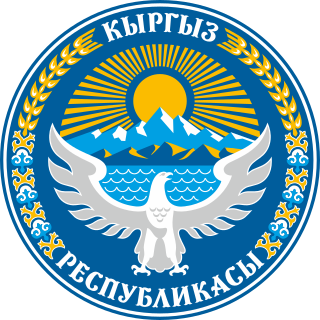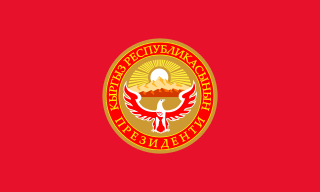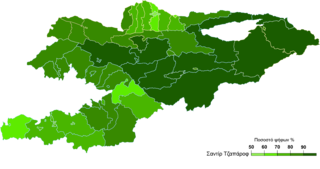
The history of the Kyrgyz people and the land now called Kyrgyzstan goes back more than 3,000 years. Although geographically isolated by its mountainous location, it had an important role as part of the historical Silk Road trade route. Turkic nomads, who trace their ancestry to many Turkic states such as the First and Second Turkic Khaganates, have inhabited the country throughout its history. In the 13th century, Kyrgyzstan was conquered by the Mongols; subsequently it regained independence but was invaded by Kalmyks, Manchus, and Uzbeks. In 1876, it became part of the Russian Empire, remaining in the USSR as the Kirghiz Soviet Socialist Republic after the Russian Revolution. Following Mikhael Gorbachev's democratic reforms in the USSR, in 1990 pro-independence candidate Askar Akayev was elected president of the SSR. On 31 August 1991, Kyrgyzstan declared independence from Moscow, and a democratic government was subsequently established.

The politics of Kyrgyzstan, officially known as the Kyrgyz Republic, takes place in the framework of a presidential system representative democratic republic, whereby the President is head of state and the Chairman of the Cabinet of Ministers is head of government. Executive power is exercised by the government. Legislative power is vested in both the government and parliament. The Economist Intelligence Unit rated Kyrgyzstan an "authoritarian regime" in 2022.

Kyrgyzstan elects on the national level a head of state – the president – and a legislature. The president is elected for a tenure of single six-year term by the people. The Supreme Council is composed of 120 members filled by proportional representation.

Parliamentary elections were held in Kyrgyzstan on 27 February and 13 March 2005. The belief that the elections had been rigged by the government led to widespread protests, culminating in the Tulip Revolution on 24 March in which President Askar Akayev was overthrown.

The president of Kyrgyzstan, officially the president of the Kyrgyz Republic, is the head of state and head of government of the Kyrgyz Republic. The president directs the executive branch of the national government, is the commander-in-chief of the Kyrgyz military and also heads the National Security Council.

Felix Sharshenbayevich Kulov is a Kyrgyz politician who served as the 9th Prime Minister of Kyrgyzstan from 2005 to 2007, following the Tulip Revolution. He first served from 1 September 2005 until he resigned on 19 December 2006. President Kurmanbek Bakiyev reappointed him acting Prime Minister the same day, but parliamentary opposition meant Bakiyev's attempts to renominate Kulov in January 2007 were unsuccessful, and on 29 January the assembly's members approved a replacement.

Kurmanbek Saliyevich Bakiyev is a Kyrgyz politician who served as the second president of Kyrgyzstan, from 2005 to 2010. Large opposition protests in April 2010 led to the takeover of government offices, forcing Bakiyev to flee the country.

The Supreme Council is the unicameral parliament of the Kyrgyz Republic. It was known as the Supreme Soviet of the Kirghiz Soviet Socialist Republic until 1991.

Almazbek Sharshen uulu Atambayev is a Kyrgyz politician who served as the President of Kyrgyzstan from 1 December 2011 to 24 November 2017. He was Prime Minister of Kyrgyzstan from 17 December 2010 to 1 December 2011, and from 29 March 2007 to 28 November 2007. He served as Chairman of the Social Democratic Party of Kyrgyzstan (SDPK) from 30 July 1999 to 23 September 2011.

A new constitution of Kyrgyzstan was passed by referendum on 21 October 2007. It is based on the first post-Soviet constitution originally adopted on 5 May 1993.
Early parliamentary elections were held in Kyrgyzstan on 16 December 2007. The election was called by President Kurmanbek Bakiyev after the constitutional referendum on 21 October 2007 approved a new electoral system and constitutional reform proposals, enlarging the parliament to 90 MPs and introducing party-list voting.

A constitutional referendum was held in Kyrgyzstan on 27 June 2010 to reduce presidential powers and strengthen democracy in the wake of the riots earlier in the year. Parliamentary elections followed on 10 October 2010.

The Constitution of Kyrgyzstan was the supreme law of the Kyrgyz Republic. The constitution in force from 2010 until 2021 was passed by referendum on June 27, 2010, replacing the previous constitution. It introduced a strong parliament to the country, reducing the power of the historically strong president. The constitution is similar in many ways to the previous one.

A constitutional referendum was held in Kyrgyzstan on 11 December 2016. The constitutional amendments were approved by around 80% of voters.

Parliamentary elections were held in Kyrgyzstan on 4 October 2020. The results showed that pro-government parties had won a supermajority of seats. The election was subsequently annulled by the Central Election Commission during the 2020 Kyrgyzstan protests.

Snap parliamentary elections were held in Kyrgyzstan on 28 November 2021. They followed the annulment of the results of the October 2020 elections and the subsequent protests against the election's conduct. Six parties passed the 5% threshold needed to win seats in the parliament. Turnout hit a record low at less than 35%.

Snap presidential elections were held in Kyrgyzstan on 10 January 2021, alongside a constitutional referendum. The elections were called early following the resignation of President Sooronbay Jeenbekov in the wake of the 2020 Kyrgyzstani protests.
A referendum was held in Kyrgyzstan on 10 January 2021 alongside presidential elections. The referendum asked voters if Kyrgyzstan should adopt a presidential system of government, a parliamentary system, or neither. 84% of voters chose to readopt a presidential system.

The Constitution of Kyrgyzstan is the supreme law of the Kyrgyz Republic. Kyrgyzstan first got a constitution in 1993, a year and a half after the country had gained independence from the Soviet Union in 1991. It has gone through a few constitutions, with the last one being adopted in April 2021.

The Social Democrats is a political party in Kyrgyzstan founded in late 2019 by supporters of former President Almazbek Atambayev - legal successor from the Social Democratic Party of Kyrgyzstan (SDKP). After a conflict between Atambaev and his successor President Sooronbai Jeenbekov emerged and deepened in 2018, Atambayev accused of Jeenbekov in attempting to seize authority over the SDKP, a party that Atambayev himself formed in 1990s and served as a leader of. The SDK participated in the annulled 2020 parliamentary election. Current party leader is Temirlan Sultanbekov.











